Waldorf News
Feeding the Future: An Exemplary School Food Program at Living Oaks
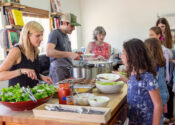
By Stephanie Welch
In an era where school lunch programs have largely devolved to reheating commercially produced, frozen foods – prioritizing cost, convenience, and adherence to grossly inadequate federal nutrition guidelines over genuine dietary value – it’s clear that our children’s health and well-being are under threat.
Not only are these meals highly processed, but, since they are now often sourced through fast food companies, many are contaminated with toxins while being mainly devoid of real nutrition.*
In the midst of this growing nutritional crisis, the Living Oaks Private Educational Association, in Dripping Springs, Texas, is a paragon of what school food programs can and should be.
Here, a world-class lunch program is intertwined with a biodynamic farming initiative, offering students some of the healthiest meals in the country, as well as an in-depth educational experience.
Living Oaks’ approach both nourishes children’s bodies with high-quality, nutritious food and enriches their minds with knowledge about – and respect for – the earth that sustains us.
The school lunch program doesn’t just serve food; it sows the seeds for a healthier, more sustainable future. In this remarkable program, each meal is a lesson, and every bite is a step toward a better world.
Austin’s Freedom School Cooperatives
Nestled in the verdant landscape of Texas Hill Country, Living Oaks is a unique educational endeavor born out of a community’s vision for a natural, unrestricted learning environment.
It is one of Austin’s several freedom school cooperatives that emerged in response to the changing educational climate precipitated by the Covid-19 pandemic.
The pandemic had altered the landscape of education, and a group of parents, increasingly concerned by the stringent measures imposed on traditional schools, sought to reclaim the educational narrative for their children.
Under a bridge in 2020, they held hands and made a collective decision that sparked the creation of the Freedom Family Co-Op, which later branched into three different schools.
These families united with the goal of providing in-person education free from the constraints that had become synonymous with the pandemic era.
Initially holding classes in a rented venue that hosted other events on the weekends, the co-op was more than a stopgap measure.
It was a statement, a community’s bold step toward educational sovereignty and a return to learning in harmony with nature’s rhythms.
A Waldorf-Inspired Educational Oasis
Antonia Wilemon and her husband, Rance, long-time Austin residents and parents, had found themselves at a crossroads, yearning for a more grounded upbringing for their children away from the relentless advance of technology and digital media.
Both had backgrounds in real estate, and, as part of the Freedom Family Co-Op, they played a key role in the search for a more permanent location.
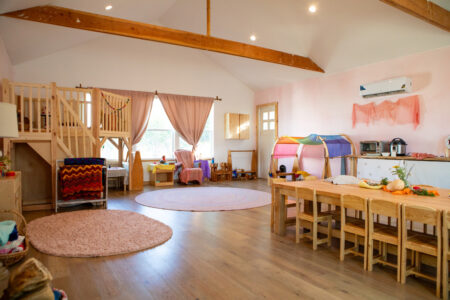
Sarvey T. Rector Photography
Soon, their quest for a permanent haven for the original school evolved into a vision for something greater: Living Oaks. Capitalizing on their real estate acumen in pursuit of their Waldorf-inspired educational values, they embarked on a journey to create a school that would serve as a sanctuary for holistic learning. The couple’s diligent search for land culminated in an off-market property purchase that was too serendipitous to pass up.
The transformation of that property into a thriving educational environment was arduous yet fulfilling. With a modest house and garage as the only original buildings on the land, they secured a construction loan and began the labor of love to erect six classrooms.
Their dedication to Waldorf principles guided every decision, including the choice of natural materials and local craftsmanship for the school’s infrastructure.
When it came time to implement an aligned way of feeding the incoming students, a teacher’s fortuitous recommendation provided a reminder of a groundbreaking program Rance had encountered online a couple of years prior: School of Lunch.
The Wilemons reached out to two of its founders, Hilary Boynton and Chuck Barth, who came for a visit that solidified the partnership, setting the cornerstone for a lunch program that would soon become a central feature of Living Oaks.
Nutritional Enlightenment Through Culinary Education
School of Lunch evolved from Hilary’s personal health quest as a mother into a mission to revolutionize school nutrition. Her exploration of diet as a healing tool, influenced by the teachings of Weston A. Price and the GAPS diet, transformed her family’s life and inspired her to author a cookbook to share her newfound wisdom.
The success of her cookbook was just the beginning. Hilary’s passion for change propelled her to overhaul the food program at her children’s school, where she implemented nutrition-centric menus grounded in wholesome, traditional food practices.
Recognizing the need for broader change, Hilary, alongside business partners Chuck Barth and Joel Rodgers, established School of Lunch. This initiative offers a yearly week-long, hands-on training program, making nutritional education accessible to a wider audience, from culinary professionals to educators, thanks to scholarship opportunities.
As the concept for Living Oaks’ lunch program began to coalesce, Hilary and Chuck came up with a plan to relocate to Austin to personally spearhead its development.
During this period, Hilary reconnected with Chef Aran Goldstein, a former Boston associate who was living with his family in Portugal while developing an online cooking course. The potential for collaboration in Austin piqued Aran’s interest, prompting him to contemplate joining the venture.
Aran’s week-long exploratory stay with Hilary and Chuck in Los Angeles was a homecoming of sorts, a time of familial warmth and collaborative planning.
However, as the time to relocate to Austin drew closer, it became clear that logistics and the needs of Hilary and Chuck’s family would make their move impractical. Embracing the challenge, Aran accepted the reins of the project, prepared to lead Living Oaks’ food revolution single-handedly.
Chef Aran’s Story
Chef Aran Goldstein’s culinary journey paralleled his personal transformation as his life evolved from a childhood marred by unhealthy eating habits to a career dedicated to the nourishment and well-being of the next generation.
When he was growing up in the 1980s, Aran’s diet was reflective of the fast-food culture that was pervasive during that era, leading to personal struggles with obesity. However, these challenges sowed the seeds for a future where food would become his medium for health and education.
His professional endeavors began at a culinary school in Vermont in 2005, followed by sojourns in kitchens around the globe. Yet, it was the birth of his son that crystallized his personal mission to address the challenge of feeding children healthfully.
His culinary philosophy was refined through his encounters with the teachings of Weston A. Price, courtesy of his friend Ben Elliott, a farmer and fellow chef in Massachusetts. These experiences instilled in him a deep awareness of food’s origins and quality.
Aran’s commitment to culinary education led him from the bucolic settings of Italy, where he established a food program at the Village Forest School, to the sandy shores of Portugal, where he focused on online teaching. However, it was the call to join the pioneering food program at Living Oaks that drew him back into the heart of community nourishment.
There, Aran’s vision found its true home, as he embarked on a quest to redefine the norm for school lunches and, in the process, shape a healthier, more conscious future.
Crafting a Culinary Sanctuary
The kitchen at Living Oaks is a testament to innovation, resilience, and the profound belief that good food is the foundation of vibrant health and community.
What began as merely a garage on the property has been transformed into a central feature of the school, where Chef Aran weaves his culinary magic. His motto – ”No excuses!”- reflects the ethos that has driven the program’s evolution from his bootstrapping method of cooking on outdoor flat-top grills for the first six months to the establishment of a full-fledged commercial kitchen, brought to reality by the community’s fundraising efforts and shared dedication.
Underpinning the school’s food program are goals and priorities that transcend conventional food practices. The emphasis is on local, sustainable, and – importantly – delectable cuisine that honors the body’s need for whole, organic foods while embracing the foundational principles set forth in the teachings of Weston A. Price.
Every meal prepared is an exercise in mindfulness, from the soaking of grains to the use of reverse osmosis water systems, with the conscious intention of contributing to the food’s life-giving properties.
Sourcing ingredients is itself an art form at Living Oaks. The preference is for local farm sourcing and farm-to-table delivery services, although Chef Aran also makes personal trips to the grocery store as needed. The reality of cooking at volume and having to make occasional compromises does not deter the chef’s overall commitment to excellence; he pragmatically balances the ideal with practical considerations, such as buying high-quality meat from reputable local grocery stores when necessary. His philosophy urges balance, as expressed in the common adage not to let perfect be the enemy of good.
Communication with the students about food is navigated with care and joy. Chef Aran avoids fear-based narratives, instead fostering an environment where food is associated with happiness and health. He strives to instill a culture where nutritious food is celebrated and children learn to appreciate the strength and resilience of their bodies.
Cultivating a Connection With Food
At Living Oaks, the students’ relationship with food is nurtured to be as organic and vibrant as the gardens where many of the ingredients for their meals are grown.
The kitchen and the dining area become stages where the daily drama of food unfolds, sparking curiosity and appetite in equal measure. The kids arrive with a palpable excitement for mealtime, eager to savor favorites such as the savory chicken teriyaki or to enjoy steak day, where the meat is accompanied by zesty chimichurri and tangy pickled chilis.
This excitement is further kindled by Chef Aran’s inventive transformations, such as turning leftover sourdough baguettes into mouth-watering pizzas adorned with fresh mozzarella. Such culinary creativity showcases to the students that food can be indulgent yet wholesome, teaching them that their favorite foods can be crafted from superior ingredients without sacrifice.
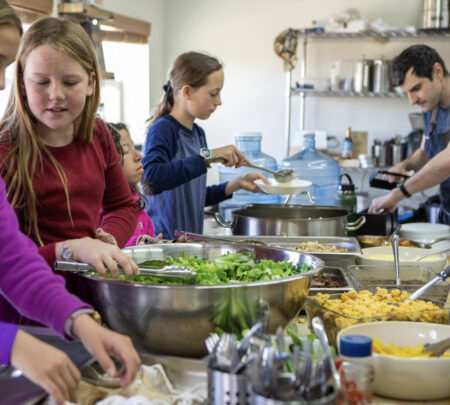
Sarvey T. Rector Photography
Living Oaks embraces dietary diversity, ensuring that every child’s nutritional needs and preferences are met with care and creativity. Addressing dietary regimens from vegetarian to dairy-free, gluten-free, and low histamine, the kitchen maintains a mantra of adaptability. Chef Aran, with his “we make it work” attitude, crafts dishes that are inclusive, ensuring that no child feels left out of the food experience.
The transformation in the children’s well-being is palpable. Parents and teachers alike note improvements in health and behavior. One parent commented on a child’s cleared psoriasis, while teachers have reported enhanced focus in the classroom. The connection between diet and well-being is visible, validating the school’s food philosophy.
In this culinary sanctuary, children are not passive consumers but active participants. Even the youngest students are woven into the rhythms of the kitchen, contributing to the preparation of the day’s meals.
Second graders might be found meticulously cleaning and splitting Brussels sprouts, their small hands acquiring the skill and discipline of kitchen work. Meanwhile, middle schoolers undertake more complex culinary tasks, such as making tortillas from scratch or learning the subtleties of preparing the perfect risotto.
These experiences are more than practical lessons; they are sensory and intellectual explorations. The children engage with the raw ingredients, learning the importance of each step in the process, from the garden to the plate.
The visceral experience of handling food – from feeling the cool earthiness of beetroot to meeting the tactile challenge of butchering a chicken – leaves a lasting impression, fostering a deep respect for the food they eat.
Beyond the kitchen, the holistic approach of the Living Oaks program extends to the school’s biodynamic gardens and animal husbandry programs, where the cycle of life is respected and celebrated. Here, children witness firsthand the realities of food production, including the raising and processing of animals.
These experiences are handled with sensitivity and care, ensuring that students develop a balanced understanding of food as a precious resource that deserves respect from farm to table.
Sowing the Seeds of Biodynamic Knowledge
The biodynamic farming program at Living Oaks is a living classroom where children learn the rhythms of nature and the intimate connection between the earth and the food it bears.
Bridget Kelley, with her rich background in microbiology and naturopathic medicine, guides this program, infusing it with her deep understanding of the nutritional and healing aspects of biodynamic practices.
Bridget’s journey into biodynamic farming began in Southern California as a volunteer at the Highland Hall Waldorf School farm. Her scientific background drove her curiosity about the nutritional benefits of biodynamic farming, especially its impact on soil health and, consequently, human health.
After receiving certification from the Rudolf Steiner College, Bridget applied these principles to her own garden with impressive results, eventually leading her to develop a comprehensive gardening curriculum for grades 1 through 8.
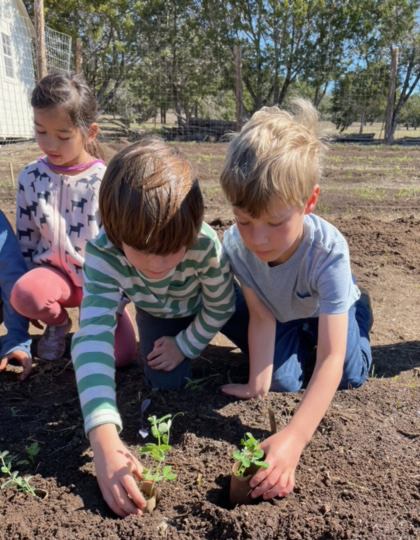
Courtesy of Living Oaks
At Living Oaks, Bridget has crafted a program where biodynamics is not simply a method but a philosophy that the students live and breathe.
The biodynamics approach, pioneered by Rudolf Steiner, views farming holistically, integrating the cosmos’s influences – the cycles of the moon, the positioning of the planets, and the constellations – into agricultural practices.
Biodynamic farming enriches the soil through specific preparations that enhance its vitality and ability to connect with the cosmic rhythms.
The school’s gardens, a 1000-square-foot teaching space, weave together a tapestry of thematic plots, including a mini food forest with diverse fruit trees and gardens dedicated to dyes, butterflies, and the Three Sisters method of planting corn, beans, and squash as companion crops.
Here, students are involved in gardening throughout the school year, planting both fall crops, including lettuce, spinach, and kale, and spring favorites, such as beans, squash, and tomatoes.
In the process, children come to understand the biodynamic calendar, which dictates the optimal times for sowing and harvesting. They engage in seed saving, selecting those plants best suited to their local conditions, an exercise in adaptation and resilience.
By integrating regenerative practices – such as composting, no-till farming, and companion planting – into the curriculum, Bridget ensures that the principles of permaculture and sustainability are not abstract concepts but lived experiences for the students.
The biodynamic philosophy sees the farm as a living organism with interconnected parts, and at Living Oaks, the children are integral to this organism. They stir and spray biodynamic soil preparations, learning firsthand how to create “herbal medicine” for the soil.
Older students delve into the subtleties of the planting calendars, receiving lessons in stewardship, observation, and the delicate balance of ecosystems.
Bridget’s biodynamic program also includes a practical understanding of the relationship between animals and agriculture. The students are involved in caring for the school’s chickens, collecting eggs, and supporting the cycle of life that connects the compost pile, seen as the heart of the farm, with the rest of the agricultural system.
The humane raising and processing of animals for food are approached with reverence and gratitude, reflecting the principle of respect for all living things.
Under Bridget’s guidance, Living Oaks students experience the full cycle of life in the garden, from the soil to the dining table and compost pile and back again. This immersive, hands-on education fosters an appreciation for the intricacies of food production and the importance of sustainable practices.
It’s a program that, in addition to teaching children how to grow and prepare food, also instills in them the values of environmental ethics, nutritional wisdom, and the beauty of working in harmony with nature.
Planting Seeds for Nationwide Change
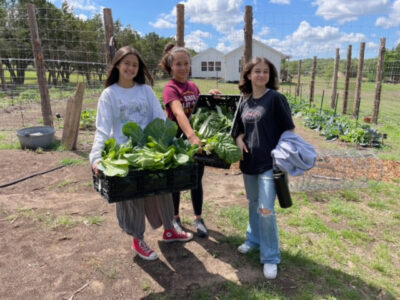
Courtesy of Living Oaks
The visionary food and farming programs at Living Oaks are not just transformative for the students and community directly involved; they represent a scalable model of what could be achieved in schools across the nation.
With nutrition education often sidelined in favor of more commercial, efficiency-driven food solutions, Living Oaks stands as a testament to the power of hands-on, sustainable, and health-focused food programs.
The ambition to scale and expand these initiatives is driven by a clear understanding of nutrition’s critical role in children’s development and learning capabilities.
Living Oaks and its partners are showcasing the tangible benefits of integrating biodynamic farming and nutrition-rich school lunch programs into the educational framework. These efforts are furthered by the provision of scholarships, enabling more individuals to learn, implement, and advocate for these practices in their own communities.
Chef Aran’s evolution from kitchen maestro to program director, with many additional responsibilities, highlights a strategic shift toward amplifying impact. By mentoring new chefs and food educators, Aran hopes to effectively multiply the reach of Living Oaks’ food philosophy.
For schools and communities inspired by the Living Oaks model, the message is clear: integration and inclusivity are key. By making such food programs an integral part of the educational program, rather than an optional add-on, schools can significantly enhance their students’ learning environments and overall well-being.
The journey of scaling and expanding these programs requires collaboration, innovation, and a shared commitment to a healthier future. As Living Oaks demonstrates, when it comes to transforming school food environments, every small step can lead to substantial, nationwide change. Its model serves as a call to action for educators, parents, and policymakers alike to support and invest in food programs that truly cater to the well-being of the next generation.
Next Steps: Cultivating a Healthier Future
Bringing the kind of positive change that Living Oaks has achieved to more communities begins with awareness and individual action. You can start by finding out who is responsible for the lunch program at your local school. Engage in a conversation with them about the success of the Living Oaks model and how these concepts could benefit your school.
Share the success stories and the significant health and educational benefits that come with better food programs. Offer resources, provide articles, and connect them with the training opportunities that School of Lunch provides.
But don’t stop there. Get involved in any way you can. Whether it’s volunteering, advocating for changes, or starting a small garden, every effort counts.
Encourage the adoption of even small changes to begin with – such as introducing a locally sourced menu item or organizing a cooking class.
Every step toward better nutrition for our children is a step towards a healthier, more vibrant future for all.
Stephanie Welch, MA, came to the field of ancestral health in 2010, using an evolutionary lens to explore nutrition, physical development, and holistic health. This sharp pivot from her academic background in humanities was driven by a personal mission to counter the declining health trends she observed in society. A speaker at ancestral health conferences since 2014, she joined Price-Pottenger Nutrition Foundation in 2022 and advocates for aligning modern lifestyles with our genetic blueprint for flourishing.
From Price-Pottenger.org
 Waldorf EC Training & Intensives in Canada
Waldorf EC Training & Intensives in Canada Grade Level Training in Southern California
Grade Level Training in Southern California Bay Area Teacher Training
Bay Area Teacher Training Art of Teaching Summer Courses 2025
Art of Teaching Summer Courses 2025 Full-Time Teacher Education
Full-Time Teacher Education Jamie York Books, Resources, Workshops
Jamie York Books, Resources, Workshops Discovering the Wisdom of Childhood
Discovering the Wisdom of Childhood Caring for All Stages of Life
Caring for All Stages of Life The Art of Administration and Leadership
The Art of Administration and Leadership Middle School Science With Roberto Trostli
Middle School Science With Roberto Trostli Train to Teach in Seattle
Train to Teach in Seattle Apply Today: New Cohort Starts Nov. 2025
Apply Today: New Cohort Starts Nov. 2025 Waldorf-inspired Homeschool Curriculum
Waldorf-inspired Homeschool Curriculum Space speaks. Its language is movement.
Space speaks. Its language is movement. Bringing Love to Learning for a Lifetime
Bringing Love to Learning for a Lifetime The Journey is Everything
The Journey is Everything Transforming Voices Worldwide
Transforming Voices Worldwide Quality Education in the Heartland
Quality Education in the Heartland Association for a Healing Education
Association for a Healing Education Storytelling Skills for Teachers
Storytelling Skills for Teachers Summer Programs - Culminating Class Trips
Summer Programs - Culminating Class Trips ~ Ensoul Your World With Color ~
~ Ensoul Your World With Color ~ Immersive Academics and Arts
Immersive Academics and Arts Roadmap to Literacy Books & Courses
Roadmap to Literacy Books & Courses Flexible preparation for your new grade
Flexible preparation for your new grade Dancing for All Ages
Dancing for All Ages Everything a Teacher Needs
Everything a Teacher Needs RSS Feeds
RSS Feeds